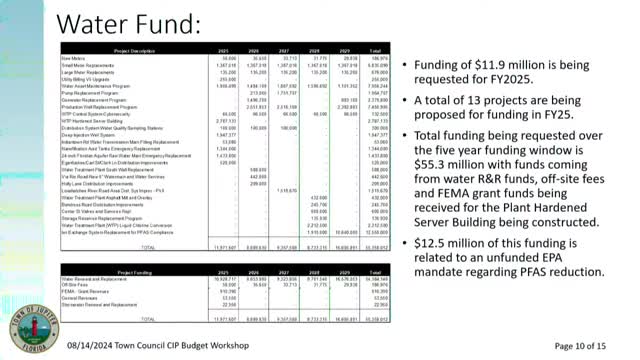Water Utility Faces Major Funding Crisis Ahead of 2029 Deadline
August 14, 2024 | Jupiter, Palm Beach County, Florida
This article was created by AI summarizing key points discussed. AI makes mistakes, so for full details and context, please refer to the video of the full meeting. Please report any errors so we can fix them. Report an error »

In a recent government meeting, officials discussed the implications of new regulatory requirements for water utilities, particularly concerning the construction of a calcite contactor and a sixth nanofiltration train for a reverse osmosis (RO) plant. The proposed budget for 2029 includes these projects, which are essential for maintaining compliance with state regulations as the utility approaches 75% of its rated capacity of 30 million gallons per day.
The discussions highlighted the potential reduction in capacity if the sixth train is not constructed, which could lead to a significant decrease of 1.8 million gallons per day. This reduction would trigger a state-mandated intensive capacity rating study, a costly and time-consuming process that utilities must undertake when nearing capacity limits.
Concerns were raised about the financial burden these projects would impose on customers, with estimates suggesting that the costs could exceed a third of annual water bills. One official emphasized the need for public vetting of such significant expenditures before they are included in the five-year plan, advocating for a more cautious approach to budgeting.
The conversation also touched on the broader implications of unfunded mandates from regulatory agencies, particularly regarding the removal of PFAS (per- and polyfluoroalkyl substances) from water supplies. The estimated cost to comply with new PFAS regulations is projected to exceed $12 million, raising alarms about the financial impact on taxpayers and the potential for litigation.
Officials expressed a commitment to engage with legislators to seek funding solutions and to ensure that the implications of these regulatory changes are fully understood. The urgency of the situation was underscored by the looming 2029 compliance deadline, with officials agreeing that proactive measures must be taken to address these challenges without placing an undue burden on the community.
As the meeting concluded, there was a consensus on the need for further discussions and clarity in the next budget cycle, with a strong emphasis on the importance of addressing these regulatory challenges collaboratively.
The discussions highlighted the potential reduction in capacity if the sixth train is not constructed, which could lead to a significant decrease of 1.8 million gallons per day. This reduction would trigger a state-mandated intensive capacity rating study, a costly and time-consuming process that utilities must undertake when nearing capacity limits.
Concerns were raised about the financial burden these projects would impose on customers, with estimates suggesting that the costs could exceed a third of annual water bills. One official emphasized the need for public vetting of such significant expenditures before they are included in the five-year plan, advocating for a more cautious approach to budgeting.
The conversation also touched on the broader implications of unfunded mandates from regulatory agencies, particularly regarding the removal of PFAS (per- and polyfluoroalkyl substances) from water supplies. The estimated cost to comply with new PFAS regulations is projected to exceed $12 million, raising alarms about the financial impact on taxpayers and the potential for litigation.
Officials expressed a commitment to engage with legislators to seek funding solutions and to ensure that the implications of these regulatory changes are fully understood. The urgency of the situation was underscored by the looming 2029 compliance deadline, with officials agreeing that proactive measures must be taken to address these challenges without placing an undue burden on the community.
As the meeting concluded, there was a consensus on the need for further discussions and clarity in the next budget cycle, with a strong emphasis on the importance of addressing these regulatory challenges collaboratively.
View full meeting
This article is based on a recent meeting—watch the full video and explore the complete transcript for deeper insights into the discussion.
View full meeting